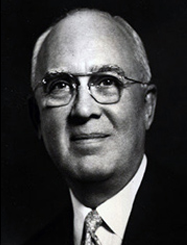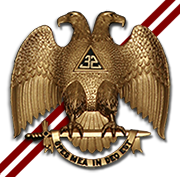

Frank S. Land, 33° GC
Founder of DeMolay
(Jun 21, 1890-Nov 8, 1959)
1912 - Raised, Ivanhoe Lodge #446
Life Member, Ivanhoe Lodge #446
1912 - 32° Consistory of Western Missouri, Kansas City
1919 - Knight Commander of the Court of Honour
1919-20 - Commander, DeMolai Council of Kadosh
1925 - Coroneted 33° Inspector General Honorary
1955 - Grand Cross, Scottish Rite
SMJ
1914-20 - Secretary, Social Services
1912 - Kansas City Chapter No. 28, R.A.M.
1912 - Shekinah Council No. 24, R. & S.M.
1913 - Kansas City Commandery No. 10, K.T.
1944 - Affiliated, Kansas City Council No. 45
1946 - Mary Conclave No. 5, Red Cross of Constantine
1950 - Sovereign Mary Conclave No. 5, Red Cross of Constantine
1951 - International Gold Service Medal, Grand Chapter of York Rite
1931 - Potentate of Ararat Shrine
1954-55 - Imperial Potentate, Shrine of North America
Trustee, Harry S. Truman Presidential Library & Museum
1958 - President, Kansas City School Board
Occupation: Restaurateer, Executive Officer for DeMolay
President of the Kansas City School Board,
Director of the Columbia National Bank, Kansas City; member of executive committee of the National Security Commission, Washington; member of the American Advisory Council, Yenching University, Peiping, China; and member of the National Youth Week Committee for United States.
Frank Sherman Land founded the Order of DeMolay in
1919, in Kansas City, Missouri. Frank S.
Land. Land was a community leader
who, at the age of 28, already
had a successful business career
as a restaurateur behind him.
Illustrious Brother Land grew up with a strong religious influence in his life. When ten years old, he conducted a Sunday school class of 300 and was known as the "Boy preacher."
The
main event that lead to the founding
of the DeMolay movement was World
War I. This was a time when the
nation was caught up with a passion
and desire to bring democracy
to the world. When the United
States joined in the fight against
German power, every resource of
men and materials was poured into
the war effort. America suffered
not only the loss of its men who
had fallen in battle, but on the
home-front as well. A positive
response to this critical situation
came about with the development
of many charitable organizations.
Frank S. Land was selected to
act as the director of the Masonic
Relief and Employment Bureau of
the Scottish Rite of Freemasonry.
This charity would come to help
thousands of families.
Near
the end of the war, Land became
concerned with the problems of
boys who had lost their fathers.
He thought "how lonely it must
be for a boy not to have a man
to talk with, or a man to provide
some type of inspiration and direction."
Frank decided there was a need
for an organization where boys
would have the opportunity to
associate with other boys, a place
they could share common interests,
learn responsibility and other
skills that would benefit them
throughout their lives. His ideal
model for this organization included
having business or professional
men, Masons, taking interest in
the young people, being a friend
to them, advising them, and perhaps
even providing them with employment
opportunities.
In
March, 1919, Land met with young
Louis Lower. Louis' father had
died, leaving the young man without
a father figure in his life. Land
took the time to listen to Louis,
learn about his dreams, and to
help him. He learned that others,
like Louis, sought companionship,
leadership, inspiration and competition.
He asked Louis to invite some
friends to a meeting, the original
group of nine DeMolays: Louis
G. Lower, Ivan M. Bentley, Edmund
Marshall, Gorman A. McBride, Jerome
Jacobson, William W. Steinhilber,
Elmer Dorsey, Clyde C. Stream,
and Ralph Sewell. At the second
meeting, there was a total of
31 young men present. They were
excited about their new club!
The
group needed its own identity
and its own name. After Dad Land
related the story of Jacques DeMolay,
the group decided to name itself
for this historical figure connected
with Masonry.
Dad
Land, as he came to be called,
provided the philosophy and principles
to be embodied. As interest in
DeMolay spread, Land answered
many requests for information
and authority to start chapters.
Initiations and ceremonies took
place in all locations. By the
fall of 1920, Mother Chapter had
developed activities for its members
as well. These included an outstanding
baseball team, a DeMolay marching
unit, and even a 100-piece band!
By
the end of 1921, Dad Land made the decision to devote all of his time and effort to building
this new organization and he became
a full time DeMolay employee. He sold his successful restaurant and embarked on his youth work full time.
As DeMolay chapters grew in numbers
and strength, the organization
as a whole grew in prestige. With
this greater prestige, interest
developed in the Masonic fraternity.
Official recognition and approval
by Masonic groups began giving
their seal of approval to foster
DeMolay in their states. Many
distinguished organizations endorsed
DeMolay including the General
Grand Chapter of Royal Arch Masons,
Grand Lodges, Knights Templar,
etc.
A
devoted champion of Freemasonry
and of its teachings, Land would
become a figure of international
prominence within Masonry, eventually
becoming Imperial Potentate of
Shrine of North America, later renamed Shriners International. He
counted among his friends U.S.
Congressmen, state governors,
movie and radio stars, military
leaders, leaders of industry,
Presidents of the U.S. and a veritable
legion of young men.
Illustrious Brother Land also served as Potentate
of the Ararat Shrine (1931).
Dad
Land worked tirelessly for the
Order of DeMolay until his death
on November 8, 1959. Hundreds
of other devoted workers aided
in the creation and extension
of the Order of DeMolay, but looked
to one man for guidance. Frank
S. Land was the charismatic leader
of the Order. Frank S. Land was
truly a great man, a proud American,
and a person who came to be known
by millions, simply as "Dad." Frank Land's life touched, and
continues to impact generation
after generation of young people,
young men looking to better themselves
by emulating the lessons and examples
by which he himself lived.
Interred: Mt Moriah Cemetery, Kansas City, MO.

